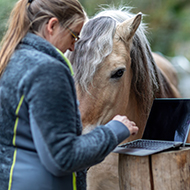Canine distemper virus docking protein mapped
The researchers hope their insights will lead to the development of antiviral drugs.
A new study has revealed the structure of the docking protein of the canine distemper virus (CDV), potentially allowing the development of antiviral drugs which would target the protein and prevent the virus from entering host cells.
As CDV is related to measles, both belonging to the genus Morbillivirus, the study could also help inform the development of an antiviral drug which could protect humans from measles.
Although vaccines exist for both diseases, worldwide 100,000 people still die each year from measles and CDV can cause epidemics in wild animals as well as affecting domestic dogs in areas where there is limited vaccination.
The researchers from the University of Bern and the Zurich University of Applied Science used cry-electron microscopy (cryo-EM) to map the viruses’ H-Protein, also known as the docking protein, at molecular level, revealing that the protein has three main domains (heads, neck and stalk) in an asymmetric structure.
Knowledge of this structure could be used to develop antiviral drugs which would block the docking protein. The researchers involved in the study, alongside scientists from the University of Marseille, have already successfully identified antibodies that can neutralise CDV.
Dimitrios Fotiadis, one of the co-authors of the study, said: “The fact that we were able to determine the structure represents a big leap forward. This now allows us to understand how the different subdomains spatially organize with each other - and provides us with a valuable blueprint to develop next-generation antiviral drugs that block the 'docking protein’.”
Philippe Plattet, another of the co-authors, said: "Simultaneously blocking the cell entry process in distemper and measles virus with several different neutralizing molecules is a promising antiviral strategy.”
The study was published in Proceedings of the National Academy of Science USA.



 With Strangles Awareness Week just around the corner (5-11 May), vets are being encouraged to share a survey about the disease with their horse-owning clients.
With Strangles Awareness Week just around the corner (5-11 May), vets are being encouraged to share a survey about the disease with their horse-owning clients.